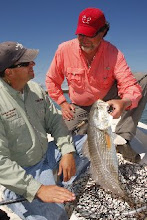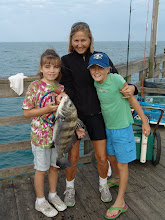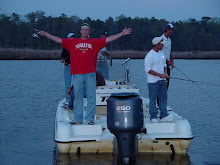Albea: North Carolina can fix what’s wrong with saltwater management
By Craig Holt - January 13, 2012
Joe Albea, 57, remembers when Pamlico Sound was full of big croakers and gray trout, along with many other species.
“Croakers and gray trout were the two breadwinners in the sound back in the ’70s,” said Albea, a Greenville native who produces and hosts two UNC-TV shows: Carolina Outdoor Journal and Exploring Carolina. “Fishing was great for recreational and commercial anglers then, but we didn’t have the big trawlers out there.”
Now, years after large ocean-going trawls started using the sound, anglers can find a few croakers, but they’re mostly tiny fish, usually less than a pound in weight, and the gray trout have all but disappeared.
To paraphrase the words at the end of the move “King Kong:” “T’wasn’t netting that killed the sound, but big nets.”
Commercial – and to a lesser extent, recreational – fishing also has ripped apart Southern flounder stocks and kept spotted seatrout numbers and sizes low, as well as red drum – until they finally were protected somewhat by a 10-fish netting by-catch allowance and a daily hook-and-line limit of one fish.
But Albea, who saw the North Carolina coast once support both activities, isn’t dead set against all netting.
“It’s just the amount of gear … and the large trawlers,” he said. “Back in the day of small, wooden trawl boats, they didn’t tear up the sound as bad, and by-catch wasn’t as big an issue. Today, the big ocean steel-haul trawlers continue to turn over the bottom.
“Commercial gear and recreational pressure, to some extent, destroyed inside flounder. No fishery can sustain that kind of pressure, and Pamlico Sound, as big as it is, has paid the price.”
After the N.C. Division of Marine Fisheries put restrictions on the recreational giggers’ take of flounder – setting identical limits to those governing hook-and-line anglers – commercial fishermen simply turned to gill nets and pound nets, which could be fished without restriction. Not only that, but the minimum size netters were permitted to land was an inch shorter than the recreational size limit. And the slaughter continued.
For example, when the recreational size limit for flounder was 12 inches and the commercial size limit was 11 inches, flounder larger than 12 became as scarce as abortionists at a Rick Santorum rally.
“Back in the history of Pamlico Sound, sailors had a hard time navigating the sound because of its oyster beds. I’m pretty sure when the big trawlers started entering the sound, that’s when the oyster beds started going downhill,” Albea said.
Ocean-going trawlers drag heavy chains across the bottom, kicking up shrimp and other species that are caught in the trawler’s tail bags, then hoisted aboard ship. But this method destroys the habitats of oysters and clams, and it tears up underwater grasses where baitfish and even ocean species spawn and their fry hide. With no protection, small fish are easy prey for larger predators.
“There’s also the by-catch problem,” Albea said.
By-catch is a term to describe “incidental take” of untargeted fish in order to land a valuable commercial species, in particular, shrimp.
“I know it’s been said for each pound of shrimp, trawl nets kill 10 pounds of other species, but I’ve talked to experts who say that ratio is much higher,” Albea said.
When Florida voted to ban inshore netting in 1994 – six years after giving gamefish status to red drum – it created another problem for North Carolina’s saltwater fishery.
“A lot of the Florida people moved to North Carolina,” Albea said.
The N.C. Division of Marine Fisheries allowed the Floridians to purchase North Carolina commercial fishing licenses, and North Carolina residents could transfer or sell their commercial licenses to the Floridians – even though North Carolina had put a moratorium on the sale of additional commercial licenses. Commercial fishermen from Florida were particularly interested in landing striped mullet, a species they decimated through years of netting in the Sunshine State.
“The Florida guys showed our commercial guys a lot of their tricks,” Albea said.
A favorite technique is to set a net across the mouth of a creek, motor to the back of the creek, and then whack the sides of the boat with a paddle while moving forward, scaring the fish toward the creek mouth and into the net.
“A strike netter can clean out a creek of specks in less than an hour,” Albea said.
And until recently, North Carolina never had an annual total-allowable catch for speckled trout.
As for the gamefish bill and its reincarnation as part of the legislature’s Committee on Marine Fisheries, Albea said the issue is fairly simple.
“It’s the state’s decision whether or not we want a world-class fishery for those three species (red drum, speckled trout and striped bass), and a high-quality fishery for other species,” Albea said. “We can’t have Mother Nature, recreational and commercial fishing putting this much pressure on certain species, especially speckled trout.”
Albea has fought many battles successfully for natural resources at the North Carolina coast, including opposing a proposed paper mill and barges on the Roanoke River “smack in the middle of the best striped bass spawning grounds on the east coast,” plus the OLF – “a 7-year battle against the Navy” – and more recently, proposed windmills in the same area as the OLF.
But Albea always has preferred to remain in the background as an idea man and technical advisor.
“I’ve never used Carolina Outdoors Journal to promote any position,” he said. “It’s just a fishing show, mainly. Oh, I’ve been accused of using the show to promote positions, but that’s never been true and never will happen.”
Now, however, he’s stepping forward.
“In my opinion, (the saltwater fisheries decline in North Carolina) is a problem that’s been building over 30 years,” Albea said, “and we’ve all, recreational and commercial fishermen, contributed to it in certain ways.
And now we need to fix it.”
Keep up with all the developments on the fight to protect redfish, trout and stripers on the special NorthCarolinaSportsman.com page dedicated to gaining gamefish status for these valuable saltwater fisheries.
“Croakers and gray trout were the two breadwinners in the sound back in the ’70s,” said Albea, a Greenville native who produces and hosts two UNC-TV shows: Carolina Outdoor Journal and Exploring Carolina. “Fishing was great for recreational and commercial anglers then, but we didn’t have the big trawlers out there.”
Now, years after large ocean-going trawls started using the sound, anglers can find a few croakers, but they’re mostly tiny fish, usually less than a pound in weight, and the gray trout have all but disappeared.
To paraphrase the words at the end of the move “King Kong:” “T’wasn’t netting that killed the sound, but big nets.”
Commercial – and to a lesser extent, recreational – fishing also has ripped apart Southern flounder stocks and kept spotted seatrout numbers and sizes low, as well as red drum – until they finally were protected somewhat by a 10-fish netting by-catch allowance and a daily hook-and-line limit of one fish.
But Albea, who saw the North Carolina coast once support both activities, isn’t dead set against all netting.
“It’s just the amount of gear … and the large trawlers,” he said. “Back in the day of small, wooden trawl boats, they didn’t tear up the sound as bad, and by-catch wasn’t as big an issue. Today, the big ocean steel-haul trawlers continue to turn over the bottom.
“Commercial gear and recreational pressure, to some extent, destroyed inside flounder. No fishery can sustain that kind of pressure, and Pamlico Sound, as big as it is, has paid the price.”
After the N.C. Division of Marine Fisheries put restrictions on the recreational giggers’ take of flounder – setting identical limits to those governing hook-and-line anglers – commercial fishermen simply turned to gill nets and pound nets, which could be fished without restriction. Not only that, but the minimum size netters were permitted to land was an inch shorter than the recreational size limit. And the slaughter continued.
For example, when the recreational size limit for flounder was 12 inches and the commercial size limit was 11 inches, flounder larger than 12 became as scarce as abortionists at a Rick Santorum rally.
“Back in the history of Pamlico Sound, sailors had a hard time navigating the sound because of its oyster beds. I’m pretty sure when the big trawlers started entering the sound, that’s when the oyster beds started going downhill,” Albea said.
Ocean-going trawlers drag heavy chains across the bottom, kicking up shrimp and other species that are caught in the trawler’s tail bags, then hoisted aboard ship. But this method destroys the habitats of oysters and clams, and it tears up underwater grasses where baitfish and even ocean species spawn and their fry hide. With no protection, small fish are easy prey for larger predators.
“There’s also the by-catch problem,” Albea said.
By-catch is a term to describe “incidental take” of untargeted fish in order to land a valuable commercial species, in particular, shrimp.
“I know it’s been said for each pound of shrimp, trawl nets kill 10 pounds of other species, but I’ve talked to experts who say that ratio is much higher,” Albea said.
When Florida voted to ban inshore netting in 1994 – six years after giving gamefish status to red drum – it created another problem for North Carolina’s saltwater fishery.
“A lot of the Florida people moved to North Carolina,” Albea said.
The N.C. Division of Marine Fisheries allowed the Floridians to purchase North Carolina commercial fishing licenses, and North Carolina residents could transfer or sell their commercial licenses to the Floridians – even though North Carolina had put a moratorium on the sale of additional commercial licenses. Commercial fishermen from Florida were particularly interested in landing striped mullet, a species they decimated through years of netting in the Sunshine State.
“The Florida guys showed our commercial guys a lot of their tricks,” Albea said.
A favorite technique is to set a net across the mouth of a creek, motor to the back of the creek, and then whack the sides of the boat with a paddle while moving forward, scaring the fish toward the creek mouth and into the net.
“A strike netter can clean out a creek of specks in less than an hour,” Albea said.
And until recently, North Carolina never had an annual total-allowable catch for speckled trout.
As for the gamefish bill and its reincarnation as part of the legislature’s Committee on Marine Fisheries, Albea said the issue is fairly simple.
“It’s the state’s decision whether or not we want a world-class fishery for those three species (red drum, speckled trout and striped bass), and a high-quality fishery for other species,” Albea said. “We can’t have Mother Nature, recreational and commercial fishing putting this much pressure on certain species, especially speckled trout.”
Albea has fought many battles successfully for natural resources at the North Carolina coast, including opposing a proposed paper mill and barges on the Roanoke River “smack in the middle of the best striped bass spawning grounds on the east coast,” plus the OLF – “a 7-year battle against the Navy” – and more recently, proposed windmills in the same area as the OLF.
But Albea always has preferred to remain in the background as an idea man and technical advisor.
“I’ve never used Carolina Outdoors Journal to promote any position,” he said. “It’s just a fishing show, mainly. Oh, I’ve been accused of using the show to promote positions, but that’s never been true and never will happen.”
Now, however, he’s stepping forward.
“In my opinion, (the saltwater fisheries decline in North Carolina) is a problem that’s been building over 30 years,” Albea said, “and we’ve all, recreational and commercial fishermen, contributed to it in certain ways.
And now we need to fix it.”
Keep up with all the developments on the fight to protect redfish, trout and stripers on the special NorthCarolinaSportsman.com page dedicated to gaining gamefish status for these valuable saltwater fisheries.
 |
| Courtesy of Joe Albea |
| Joe Albea of Greenville has been a crusader for coastal resources for many years, and he's now pushing for changes in the management of redfish, speckled trout and stripers fisheries in North Carolina. |


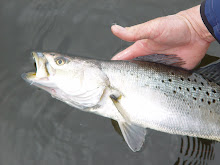



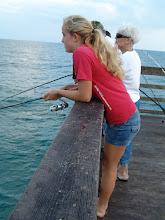

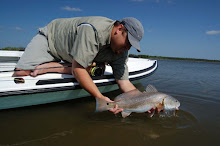.jpg)


